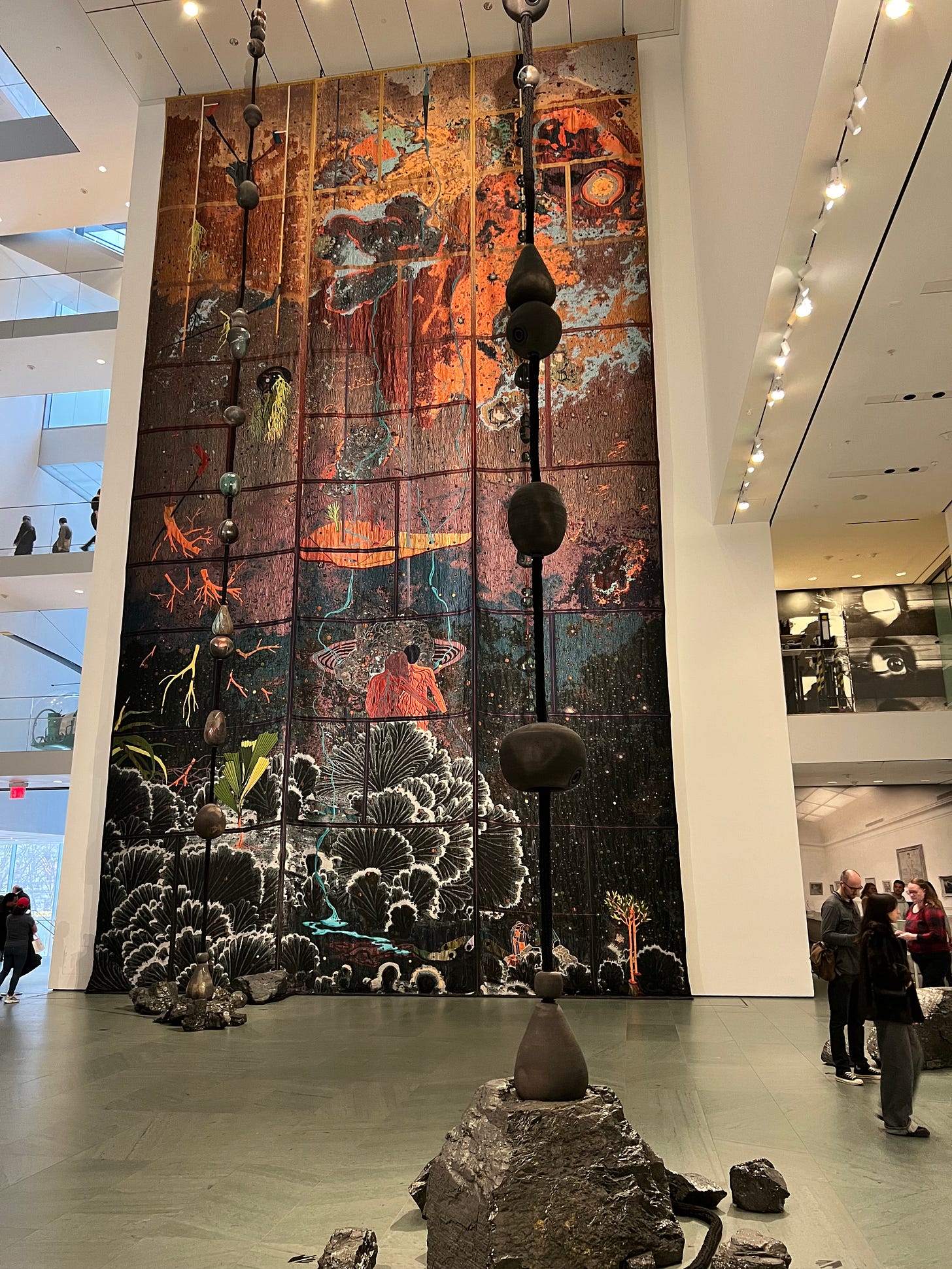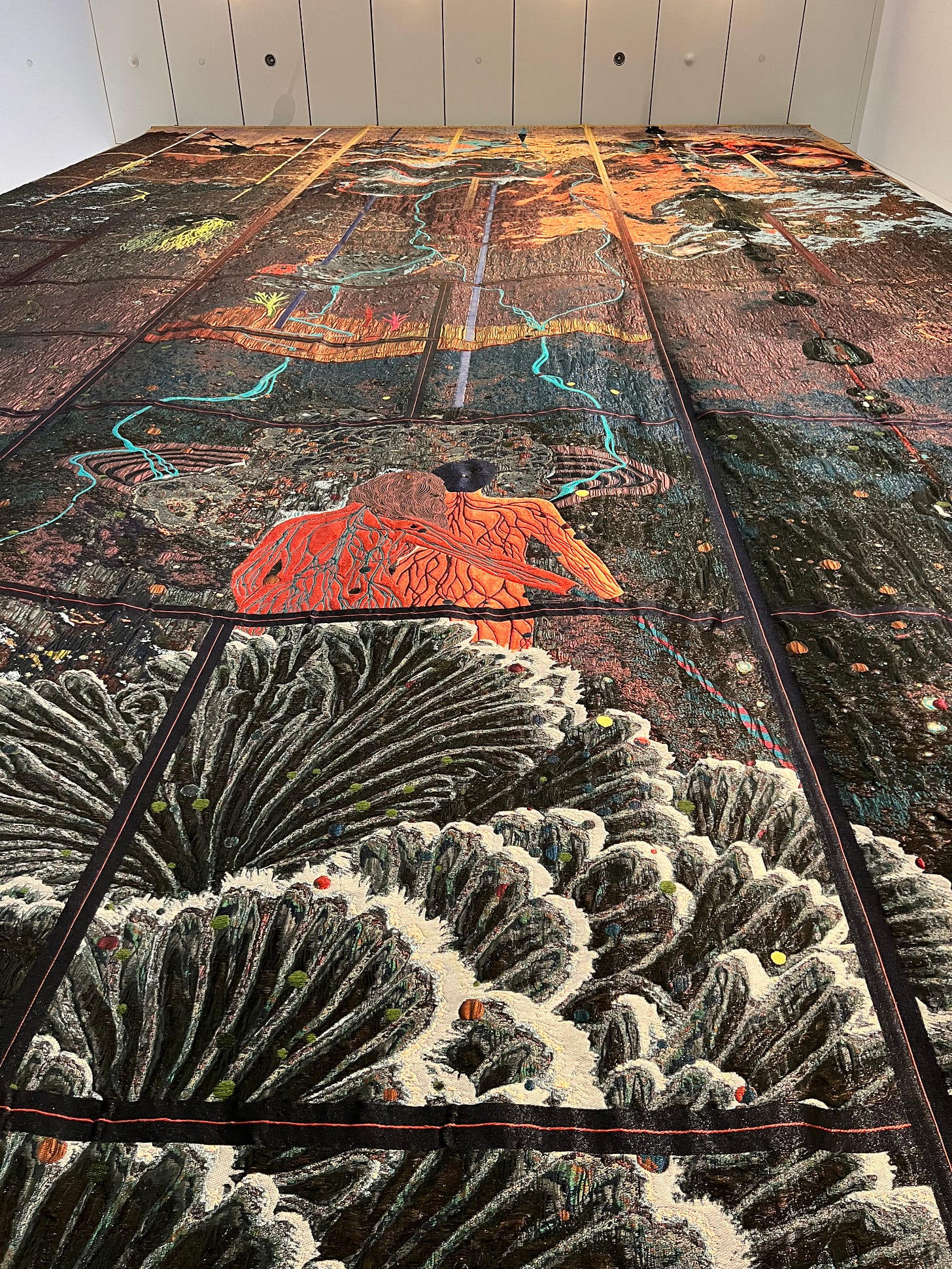A colleague and I were at the MoMA studying Nigerian-Belgian artist, Otobong Nkanga’s epic tapestry, Cadence when a guard yelled at us for getting too close. We stepped back over the gray line marked on the floor, giggling. As textile people, we can’t help but want to touch and feel, especially a surface as alluring and complex as this one. Hanging in the Atrium on the second floor, this monumental work is 65 feet high, 36 feet wide, and four layers thick. The language of jacquard weaving is used to create a composition both richly detailed and cosmic in scope.
“It’s a mix of different worlds—from the underworld and the mining of minerals, to the surface and the soil, to the atmosphere and the heat of the sun, into outer space—all collapsing together in one place. That’s what creates the cadence of life. ” - Nkanga
Nkanga’s interest in textiles began in her childhood in Nigeria, where she was exposed to batik dyeing. As a contemporary artist, she looks to push the boundaries of materials and technology. To fabricate Cadence, Nkanga collaborated with TextielLab, a modern workshop at the TextielMuseum in the Netherlands. This piece is the latest in a series of collaborations between the artist and this dynamic institution.
Intensive planning for the MoMA commission took place over the course of a year and a half. The artist was able to take advantage of the TextielLab’s new double width loom (donated by the Dutch government), which weaves at 137” rather than the standard 54”. Seasoned product designer Stef Miero and a dedicated team of weavers were instrumental in achieving the artist’s vision. Nkanga and Miero went back and forth with small samples and sketches, adjusting the weave structures and visual layout in a time consuming, labor intensive process.
The black and white warp (which you can see weaving in this video) was split into four layers, and woven with a palette of 234 colors. Both natural and synthetic fibers were used, including a monofilament yarn (or fishing line) incorporated for its strength and transparency. A pattern of grid lines added visual structure and physical stability. The artist, a 2025 Nasher Prize laureate, hand-manipulated the yarns to obscure and reveal different layers, as well as play with color saturation. This lush materiality is only part of what makes this piece so beguiling.
“What I find fascinating about textiles is that you can tell stories in multiple ways, but there is something that has been linked to our skin over time, to our histories.” - Nkanga
There is a surreal, fever dream quality to the imagery of Cadence. Falling branches and organic matter create graphic silhouettes in the foreground, while the background is ethereal and ever-shifting. Through the chaos, thin streams of blue water find their way from top to bottom. The palette is moody, dominated by black gradating into twilight shades. Flashes of orange and copper appear like a fiery heaven from sixty feet below.
Cadence also includes sculptures made of dyed ropes, hand-blown glass, and ceramic forms, as well as ceramic tablets imprinted with the artist’s poetry. A sound installation incorporating Nkanga’s powerful voice and breathing is particularly effective in activating the surrounding space.
The couple at the center of the tapestry is poised with their backs to the viewer. Together we are watching the world fall apart and tentatively renew itself. The pair seems vulnerable in the tumultuous landscape. Perhaps they feel, as I sometimes do, stuck in a state of inertia, unsure of how to move forward or take action. Perhaps they have a plan and are waiting out the storm. Perhaps they are getting ready to lean into the void before them. Timely questions about the environment and humanity’s uncertain future are woven into this timely masterpiece.
As a designer in the home furnishings industry, I view weaving as a practical art. Nkanga’s installation is a reminder that jacquard woven fabric can do so much more than upholster chairs and block sunlight. In the right hands, it can be glorious and profound.
“Cadence” is on view at MoMA until July 27th.
Thank you for reading!







